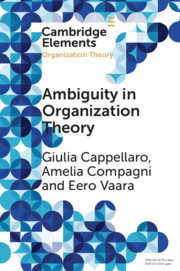Element contents
Ambiguity in Organization Theory
Published online by Cambridge University Press: 12 January 2023
Summary
Keywords
Information
- Type
- Element
- Information
- Series: Elements in Organization TheoryOnline ISBN: 9781009358460Publisher: Cambridge University PressPrint publication: 02 February 2023
References
Accessibility standard: Unknown
Why this information is here
This section outlines the accessibility features of this content - including support for screen readers, full keyboard navigation and high-contrast display options. This may not be relevant for you.Accessibility Information
This Element is free online from 16th January 2023 - 30th January 2023
- 8
- Cited by
